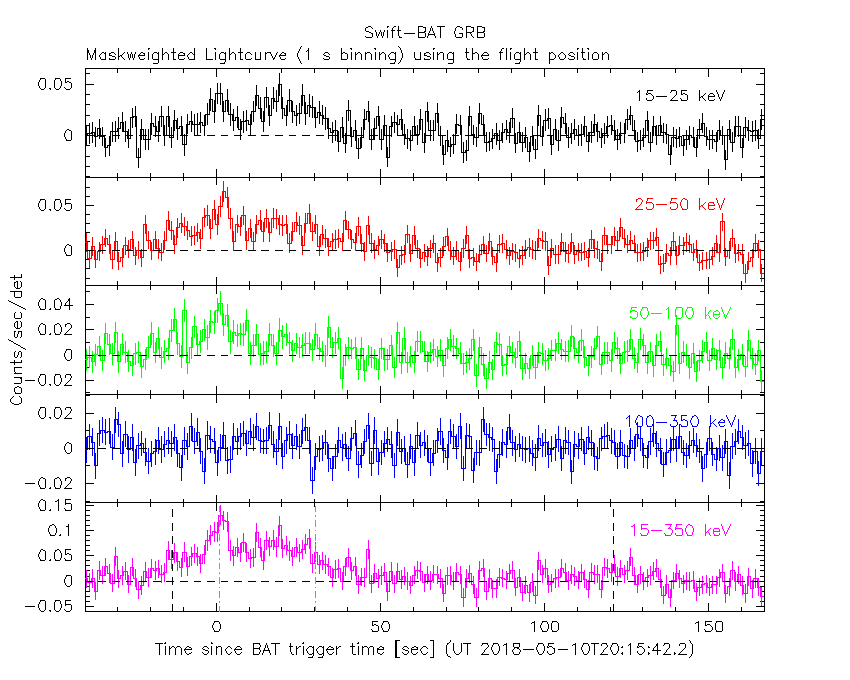
A. Tohuvavohu (PSU) and B. Sbarufatti (INAF-OAB/PSU) for the Swift team
At 20:15:42 UT, the Swift Burst Alert Telescope (BAT) triggered and located possible GRB 180510B (trigger=831816) (Tohuvavohu et al. GCN Circ. 22696). Due to an observing constraint Swift did not slew immediately to the burst. At the time of the trigger, the initial BAT position was 84° from the Sun (2.0 hours East) and 82° from the 24%-illuminated Moon. Table 1 contains the best reported positions from Swift, and the latest XRT position can be viewed at http://www.swift.ac.uk/xrt_positions.
Tohuvavohu et al. (GCN Circ. 22696) reported the discovery with UVOT of an optical afterglow. Schady (GCN Circ. 22701) reported the position from GROND for the optical afterglow of this GRB. Palmerio et al. (GCN Circ. 22702) determined a redshift of 1.305 from VLT. Table 2 is a summary of GCN Circulars about this GRB from observatories other than Swift.
Standard analysis products for this burst are available at https://gcn.gsfc.nasa.gov/swift_gnd_ana.html.
As reported by Barthelmy et al. (GCN Circ. 22705),
the BAT ground-calculated position is RA, Dec = 77.965, -62.320 deg which is RA(J2000) = 0
The mask-weighted light curve (Figure 1) shows a weak pulse that starts at ~T-20 s and peaks at ~T+1 s.
The main pulse ends at ~ T+40 s, and there is some low-level emission that lasts until ~T+140 s.
The time-averaged spectrum from T-19.92 to T+137.10 s is best fit by a simple power-law model.
The power law index of the time-averaged spectrum is 2.00 ± 0.17.
The fluence in the 15-150 keV band is 2.1 ± 0.2 x 1
The results of the batgrbproduct analysis are available at https://gcn.gsfc.nasa.gov/notices_s/831816/BA/.
Analysis of the initial XRT data was reported by Sbarufatti et al. (GCN Circ. 22708). We have analysed 3.3 ks of XRT data for GRB 180510B, from 3.0 ks to 90.3 ks after the BAT trigger. The data are entirely in Photon Counting (PC) mode. The enhanced XRT position for this burst was given by Beardmore et al. (GCN Circ. 22698).
The light curve (Figure 2) can be modelled with a power-law decay with a decay index of α=1.42 ± 0.12.
A spectrum formed from the PC mode data can be fitted with an absorbed power-law with a photon spectral index of 1.83 ± 0.12. The best-fitting absorption column is 1.3 (+0.4, -0.3) x 1
A summary of the PC-mode spectrum is thus:
Total column: 1.3 (+0.4, -0.3) x 1
Galactic foreground: 2.5 x 1
Excess significance: 5.0 σ
Photon index: 1.83 ± 0.12
The results of the XRT team automatic analysis are available at http://www.swift.ac.uk/xrt_products/00831816.
UVOT results are not available.

Figure 1. The BAT
mask-weighted light curve in the four individual and total
energy bands. The units are counts

Figure 2. The XRT light curve.
Any data from a crosshatched region are not included in the fit.
| RA (J2000) | Dec (J2000) | Error | Note | Reference |
|---|---|---|---|---|
| 0 |
-62°19'26.3" | 0.76" | UVOT-initial | Tohuvavohu et al. GCN Circ. 22696 |
| 0 |
-62°19'27.0" | 1.5" | XRT-final | UKSSDC |
| 0 |
-62°19'26.8" | 1.5" | XRT-enhanced | Beardmore et al. GCN Circ. 22698 |
| 0 |
-62°19'13.0" | 1.7' | BAT-refined | Barthelmy et al. GCN Circ. 22705 |
| Band | Authors | GCN Circ. | Subject | Observatory | Notes |
|---|---|---|---|---|---|
| Optical | Klotz et al. | 22700 | TAROT La Silla observatory optical observations |
TAROT | |
| Optical | Schady | 22701 | GROND detection in all bands | GROND | detection |
| Optical | Palmerio et al. | 22702 | VLT/X-shooter observations | VLT | detection |
May 12, 2018